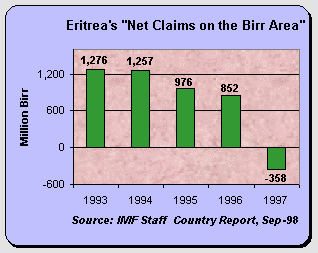Feature
Ethiopian Internet Newsletter, April 11, 1999
| |||||||||||||||||||||||||||||||||||||||||||||||||||||||||||||||||||||
 |
Eritrea borrowed over one billion birr from Ethiopia during the period June 1996 to June 1997. This money went to finance the Eritrean government's huge budget deficit. A portion of the loan also came back into Ethiopia to illegally be exchanged for dollars or to purchase Ethiopian commodities. |
From the pespective of Ethiopia, the fact that Eritrea was allowed to use the Birr was a courtesy to Eritrea. For Eritrea to use the arrangement as a means to extract dollars from Ethiopia was unacceptable.
For this reason, Ethiopia decided to change its currency at the same time as Eritrea introduced the new Nakfa notes. This prevented Eritrea from flooding Ethiopia with the Birr it collected after changing its currency. As a result, Issayas Afeworki had no leverage against Ethiopia, and was unable to force Ethiopia to allow the Nakfa to circulate in Ethiopia. The invasion of Badime seems to have been partially an instrument with which to pressure Ethiopia. Of course, Issayas badly miscalculated and the plan backfired badly.
The reason this issue was so important for Eritrea is because Eritrea had been counting the Birr as a separate external asset on the books of the three banks in Eritrea. But after the currency change, when Ethiopia refused to change the old Birr into dollars, these 'assets' became internal to Eritrea, and the balance sheets of Eritrea's banks suddenly started looking a lot worse. For example, the Commercial Bank of Eritrea had liabilities to the Commercial Bank of Ethiopia as follows:
| Accounts of the Commercial Bank of Eritrea: - Eritrea's reliance on Ethiopia to Finance its Budget Deficits and Fund Illegal Currency Trading and Commodity Purchases in Ethiopia (Unit = Millions of Birr) | |||||
| Year | 1993 | 1994 | 1995 | 1996 | 1997 |
| Cumulative Loans From Ethiopia | 156.2 | 280.6 | 665.1 | 971.3 | 2,095.1 |
| Loans from Ethiopia as percentage of Eritrean Bank Deposits | 8.1 % | 9.7% | 19.5% | 28.3% | 55.4% |
| Eritrean Government Budget Deficit (after aid grants included) |
-161.4 | -429.0 | -868.8 | -841.3 | -331.0 |
| Net Claims on Birr Area | 949.5 | 1,017.3 | 671.7 | 617.2 | -512.3 |
| Net Claims on Birr Area (after subtracting Birr holdings from 1993 ) |
0 | -88.4 | -434.0 | -488.5 | -1,618.0 |
The above table shows how dependent Eritrea was on Ethiopian financing. In particular it is shocking to note that the loans from Ethiopia were growing at a massive rate compared to deposits by Eritrean citizens, reaching 55% of the value of deposits in June 1997.
With this Birr borrowed from Ethiopia, Eritrea was probably able to engage in massive fraud.
- The economic fallout from the introduction of the new Eritrean currency is still being assessed. One outcome that threatens to sour crossborder relations is the fact that Eritrean businesses have amassed a short-term debt to Ethiopian banks of almost Birr 1 Billion ($150m). Finance officials in the Ethiopian government are threatening to clamp down on crossborder trade links as a result. (Economist Intelligence Unit, 2nd Quarter, 1998)
The following table gives some indication of suspicious activity. Note how the figure for net (hard currency) private transfers into Eritrea jumps sharply in 1997. Note also how the errors and omissions item increases by a whopping $117 million dollars in 1997. Even the IMF had to comment that the Eritrean government's figures were not too reliable given the size of the errors and omissions (equivalent to 22% of Eritrea's GNP).
| Net Private Transfers and Accounting Errors and Omissions (Unit = Millions of Dollars) | |||||
| Year | 1993 | 1994 | 1995 | 1996 | 1997 |
| Net Private Transfers | 165.4 | 276.3 | 215.3 | 243.9 | 348.4 |
| Errors and Omissions | 8.8 | -48.5 | -92.3 | -68.5 | -183.1 |
Based on the above table, it appears that a large portion of the net private transfers in 1997 was actualy due to illegal, black-market currency conversions by Eritrean government agents inside Ethiopia. Eritrea's plan was simple, use the borrowed Birr to ilegally buy dollars, and then repay Ethiopia using Birr collected when the Nakfa was introduced.
This plan was foiled when Ethiopia changed its currency and the old Birr became valueless. But Eritrea had already benefited from illegal currency trading, and based on its invasion of Ethiopia, it appears that it has no intention of repaying its loans.